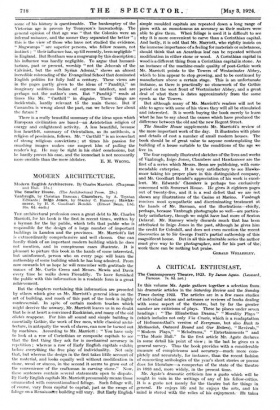MODERN ARCHITECTURE.
The Smaller House. (The Architectural Press. 25s.) Vanbrugh, by Christian Barman; Chambers, by A. Trystan Edwards ; Inigo Jones, by Stanley C. Ramsey ; Hawks- moor, by H. S. Goodhart Bendel. (Ernest Benn, Ltd. 10s. 6d. each.) THE architectural profession owes a great debt to Mr. Charles Marriott, for his book is the first.in recent times, written by
a layman for the lay public, which tells that public who is responsible for the design of a large number of important buildings in London and the provinces. Mr. Marriott's list is extraordinarily comprehensive and well chosen. One can hardly think of an important modern building which he does not mention, and in conspicuous cases illustrate. It is pleasant to picture this book in the hands of some interested, but uninformed, person who on every page will learn the authorship of some building which he has long admired. From now onwards let us hope he will remember with gratitude the names of Mr. Curtis Green and Messrs. Mewes and Davis every time he walks down Piccadilly. To have furnished the public with this information in a readable form is a great achievement.
But the chapters containing this information are preceded by others which give us Mr. Marriott's general ideas on the art of building, and much of this part of the book is highly controversial. In spite of certain modern touches which might deceive the unwary, Mr. Marriott leaves us in no doubt that he is at heart a convinced Ruskiniaii, and many of the old cliches reappear. For him all sound and simple building is essentially Gothic, the work of free men, while classical archi- tecture, in antiquity the work of slaves, can now be turned out by machines. According to Mr. Marriott : " You have only to look at a row of Corinthian or composite capitals to see that the first thing they ask for is mechanical accuracy in repetition ; whereas a row of Early English capitals exhibit before everything the free play of individuality. Not only that, but whereas the design in the first takes little account of the material, and looks equally well without modification in stone, wood or stucco, in the second it seems to grow out of the convenience of the craftsman in carving stone." Now, these sentences contain several statements open to dispute.
By Early English capitals Mr. Marriott presumably means those ornamented with conventionalized foliage. Such foliage will, of course, vary from capital to capital, just as the swags of foliage on a Renaissiu9ne building will vary. But Early English simple moulded capitals are repeated down a long range of piers with as monotonous an accuracy as their makers were able to giire them. When foliage is used it is difficult to see why it is more convenient to carve than a Corinthian capital. And lastly, it is odd that Mr. Marriott, who rightly insists on the immense importance of a feeling for materials or substances, should think that an Acanthus leaf can be repeated without modification in either stone or wood. A Corinthian capital in wood is a different thing from a Corinthian capital in stone. As an instance of the machine-made quality of post-Gothic work Mr. Marriott points to the Towers of Westminster. Abbey, which to him appear to stop growing, and to be continued by manufacture above a certain stage. This is an unfortunate instance, as there is practically no stonework of the Gothic period on the west front of Westminster Abbey, and a great deal of what there is dates approximately from the same epoch as the Towers.
But although many of Mr. Marriott's readers will not be able to agree with some of his views they will all be stimulated and interested. It is worth buying the book merely-to learn what he has to say about the causes which have produced the difference between the old and the new Regent Street.
The Smaller House supplements Mr. Marriott's review of the more important work of the day. It illustrates with plans and details of cost a number of small modern houses. The book should be of great value to anyone contemplating the building of a house suitable to the conditions of the age we live in.
The four copiously illustrated sketches of the lives and works of Vanbrugh, Inigo Jones, Chambers and Hawksmoor are the first of a series which Messrs. Benn are publishing, with com- mendable enterprise. It is very satisfactory to see Hawks- moor taking his proper place in this distinguished company, and Mr. Goodhart Renders appreciation of his work is excel- lent. Mr. Edwards' Chambers is perhaps too exclusively concerned with Somerset House. He gives it eighteen pages out of twenty-five, and it is a real defect that we are not shown any illustrations of the Casino at Marino. Vanbrugh receives most sympathetic and discriminating treatment at the hands of Mr. Barman, and the illustrations—chieflY, perhaps, because Vanbrugh photographs so well—are particu- larly satisfactory, though we might have had more of Seaton Delays!: Mr. Ramsey wisely discards much that has been attributed to Inigo Jones in the past, although he gives him the credit for Coleshill, and does not even mention the recent discoveries as to Sir George Pratt's partial authorship of this magnificent house. But in all this admirable series the author must give way to the photographer, and for his part of the; work there can be nothing but praise.
GFRATa) WELLESLEY.














































 Previous page
Previous page